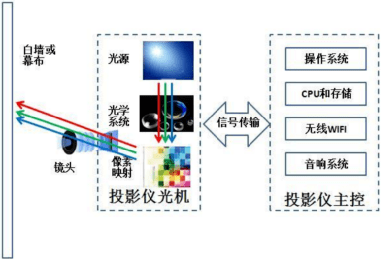



The research team led by Associate Professor Yang Yuanmu from Tsinghua University reported on Nano Letters a hybrid optoelectronic edge extraction imaging system based on superlenses working under natural lighting.

2024 will undoubtedly be a crucial year for projection industry enterprises to exhaust their resources and achieve market defense through innovative supply. It is expected that the business education market will continue to attack on intelligence, new light sources, and low costs, while the household market will continue to sprint in terms of quality to price ratio. The competition between domestic and foreign brands in the engineering market will also continue to intensify

Since 2023, the competition in technological progress in the projector industry has become increasingly fierce. The functional designs of light valves, light sources, lenses, screens, and product accessories are increasingly pursuing "brand independent discourse power" and "differentiated market consumption supply".

The research team at the University of Sydney in Australia has developed a virtual superlens technology that has successfully broken through the diffraction limit and increased imaging resolution by nearly four times. The innovation of this superlens technology is expected to greatly promote the application of super-resolution microscopy technology in medical imaging, archaeology, forensic science, and other fields.

With the continuous decline of the global economy, the consumer electronics market has generally been weak in recent years. However, the in car display market has grown against the trend driven by the trend of automotive intelligence, and is expected to surpass 200 million pieces for the first time this year, becoming the largest dark horse in the display industry

Since the record of the world of light and shadow, the lens has always existed as the most essential component. So far, 211 years have spanned three centuries. Originating in Europe, thriving in Japan and South Korea, and established in China.

The consumer electronics market has generally been weak in recent years, but the in car display market has grown against the trend driven by the trend of automotive intelligence. This year, it is expected to break through 200 million pieces for the first time and become the biggest dark horse in the display industry. BOE, Tianma, Samsung Display, LG Display, JDI, Weixinnuo, TCL Huaxing, Youda, Quchuang, Longteng Optoelectronics, Huike, Xinli and others have rushed in, trying to seize the market opportunity.

In the context of a sluggish global economic environment, smart projection, as a competitor in the television industry, has shown signs of rebounding against the trend. According to data from RUNTO, the global projector market's shipment volume reached 8.98 million units in the first half of 2023, a year-on-year increase of 7.1%.

The optical loss of superlenses has always been a key scientific issue in this field, which limits the further improvement of imaging resolution. By utilizing the multi frequency combination complex wave method to excite and obtain virtual gain, the intrinsic losses of the optical system can be offset, resulting in higher quality superlens imaging resolution.

The White Paper on Vehicle Light Field Screen and the Research Report on HUD Creating the First Screen for Drivers have been officially released Aiming to jointly explore the challenges faced by the development of car mounted screens with the industry, and propose solutions and suggestions around the experience innovation, key technologies, industry standards, and other aspects of car mounted light field screens

With the support of flexible stealth technology, ShyTech can easily integrate the screen with interior design, wake up through voice or touch commands, and automatically adjust brightness and sharpness under any lighting conditions to avoid reflection.

Early Bird Information has always been the most concerned about optical displays, which, as one of the few industries growing against the trend in 2022, shone brightly at this optical expo. Through the author's first day of on-site exploration, a special highlight was discovered, which is China's technological breakthrough in the field of ultra short focus lenses, igniting the comprehensive flowering of ultra short focus optical products.

As a member of the acceleration camp, Shengyang Optics attended the opening ceremony and participated in a series of activities. At the opening ceremony, Shengyang Optics and other member companies received warm congratulations from the leaders and guests of the Shenzhen Municipal Government, witnessing the launch of the Shenzhen Angel Industry Acceleration Camp together.

The ultra short focus lens of Shengyang Optics has broken the long-standing monopoly of ultra short focus lens patents by Japanese company Ricoh through independently designed and developed optical systems. The Shengyang Optics team has designed a new optical system that reduces the requirements for processing technology, reduces assembly difficulty, increases yield to over 85%, reduces costs by about 15%, and makes mass production easier. After mass production, the cost has a greater advantage. In terms of size, the lens size of Shengyang Optics is smaller than that of Japanese Ricoh lenses, which can better meet the current design needs of end manufacturers.